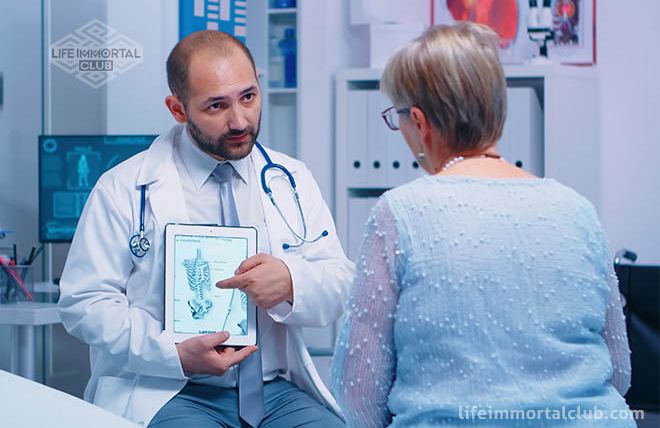Osteoporosis Treatment Guidelines
For The Prevention and Treatment of Osteoporosis

Osteoporosis is a condition characterized by low bone density and increased bone fragility, making individuals more prone to fractures. It predominantly affects postmenopausal women, but can also occur in men and younger individuals.
Early detection and intervention are crucial in preventing the progression of the disease and reducing the risk of fractures. Screening for osteoporosis is recommended for all women aged 65 years and older, as well as postmenopausal women younger than 65 who have additional risk factors.
Major risk factors for osteoporosis include advanced age, family history of fractures, personal history of fractures, low body weight or body mass index (BMI), history of smoking or excessive alcohol consumption, long-term use of certain medications (such as corticosteroids), and medical conditions like rheumatoid arthritis or endocrine disorders. Additionally, it is important to screen patients for major risk factors associated with fractures such as falls, impaired mobility or balance issues.
To screen for osteoporosis, dual-energy X-ray absorptiometry (DXA) is considered the gold standard test. It measures bone mineral density (BMD) at specific sites like the hip or spine.
A T-score is obtained from DXA results to compare an individual's BMD with that of a young healthy adult population. T-scores below -2.5 indicate osteoporosis while scores between -1 and -2.5 indicate osteopenia (low bone mass).
Prevention strategies play a fundamental role in managing osteoporosis effectively. Lifestyle modifications should be encouraged from an early age to maximize peak bone mass acquisition during childhood and adolescence.
Adequate calcium intake through diet or supplements is essential for proper bone health. The daily recommended intake varies depending on age but generally ranges between 1000-1300 mg per day for adults over 50 years old.
Vitamin D supplementation is also crucial, as it facilitates calcium absorption and promotes bone mineralization. Sun exposure can help stimulate vitamin D synthesis in the skin, but dietary sources such as fatty fish, fortified dairy products, and supplements are often necessary to meet the recommended daily intake.
Regular weight-bearing exercises like walking, jogging, or resistance training can enhance bone strength and reduce the risk of fractures. Additionally, fall prevention strategies should be implemented to minimize the risk of injury.
These include ensuring a safe living environment by removing hazards like loose rugs or cluttered spaces, improving lighting conditions in homes, utilizing assistive walking devices if necessary, and addressing any gait or balance issues through physical therapy interventions. Preventing osteoporosis starts with early detection by screening individuals at increased risk for the disease or fractures.
DXA is commonly used for diagnosis and assessment of bone mineral density. Prevention measures involve lifestyle modifications including sufficient calcium and vitamin D intake along with weight-bearing exercises.
Fall prevention strategies are essential in reducing fracture risk in susceptible individuals. By implementing these preventive measures effectively, we can significantly reduce the burden associated with osteoporosis while improving overall quality of life for those affected by this condition.
Who should be screened for osteoporosis?
Screening for osteoporosis is a crucial aspect of preventive care, as early detection allows for timely intervention. There are various guidelines that outline who should be screened for osteoporosis, which primarily focus on identifying individuals at higher risk. The United States Preventive Services Task Force (USPSTF) recommends that all women aged 65 and older should be screened for osteoporosis.
Additionally, the USPSTF suggests that screening may also be beneficial for postmenopausal women younger than 65 years who have an increased fracture risk based on clinical risk factors. In addition to age and gender, there are several risk factors that can help identify individuals who should undergo screening for osteoporosis.
These include a personal history of fractures as an adult, a family history of hip fractures, low body weight or body mass index (BMI), smoking habits, excessive alcohol consumption, and long-term use of certain medications such as glucocorticoids or anticonvulsants. It is important to note that men can also develop osteoporosis; however, there is limited consensus regarding specific screening recommendations for them.
Nevertheless, the Fracture Prevention Assessment Tool (FRAX) developed by the World Health Organization provides a useful tool to evaluate fracture risk in both men and women by considering multiple clinical factors such as age, sex, BMI, previous fractures, and parental hip fracture history. Ultimately, the decision to screen for osteoporosis should be made on an individual basis in conjunction with healthcare providers.
It is essential to consider not only age and gender but also other influential factors like medical history and lifestyle choices when determining who should undergo screening. By identifying those at higher risk early on through comprehensive screening strategies, appropriate interventions can be implemented to reduce the incidence of osteoporotic fractures and improve overall bone health outcomes.
What are the major risk factors for osteoporosis?
3. What are the major risk factors for osteoporosis? Osteoporosis is a complex condition influenced by various risk factors that can significantly increase an individual's susceptibility to developing this debilitating disease. Understanding these risk factors is crucial in identifying individuals who may be at higher risk and implementing appropriate preventive measures and treatment strategies.
One of the primary risk factors for osteoporosis is age. As individuals get older, their bone density naturally decreases, making them more vulnerable to fractures.
Postmenopausal women, in particular, experience accelerated bone loss due to hormonal changes that occur during menopause. Estrogen plays a critical role in maintaining bone health, so the decline in estrogen levels after menopause can lead to rapid bone loss and increase the risk of osteoporosis.
Another significant risk factor for osteoporosis is gender. Women have a higher likelihood of developing osteoporosis compared to men due to several reasons.
Firstly, women typically have lower peak bone mass than men, making them more susceptible to bone loss as they age. Secondly, hormonal changes during menopause further accelerate bone loss in women, as mentioned earlier.
Women tend to live longer than men on average; therefore, they have more time for progressive bone loss and an increased likelihood of experiencing fractures. Family history also plays a vital role in determining one's susceptibility to osteoporosis.
Individuals with a family history of the disease are at higher risk since genetics contribute significantly to overall bone health and density. Genetic variations affecting calcium absorption or metabolism can impact an individual's ability to build and maintain strong bones, rendering them more predisposed to osteoporotic fractures.
Understanding the major risk factors for osteoporosis is crucial for identifying individuals who may be at higher risk and require preventive measures or treatment interventions accordingly. Age-related factors such as postmenopausal hormonal changes affect both men and women differently but remain significant contributors to bone loss.
Additionally, being female and having a family history of osteoporosis further increases the likelihood of developing this condition. By targeting these risk factors, healthcare professionals can better tailor interventions to prevent and manage osteoporosis, ultimately improving patients' bone health and reducing the burden of fractures.
What are the major risk factors for fractures?
Fractures in individuals with osteoporosis can have severe consequences, impacting their quality of life and overall well-being. It is crucial to identify the major risk factors for fractures to develop effective preventive measures and treatment strategies.
Several factors contribute to an increased risk of fractures in individuals with osteoporosis. Firstly, age plays a significant role in fracture risk.
As we age, our bone density naturally decreases, making bones more prone to fractures. Women who have undergone menopause are particularly vulnerable to fractures due to the rapid decline in estrogen levels, which accelerates bone loss.
Secondly, a personal history of previous fractures is a strong indicator of increased fracture risk. Individuals who have experienced a fracture before are at higher risk of sustaining subsequent fractures.
This is partly because the initial fracture may be indicative of underlying osteoporosis or weakened bone structure that predisposes them to future breaks. Furthermore, low body weight or being underweight is associated with an elevated risk of fractures.
People with lower body mass tend to have less bone mass as well, making their bones more susceptible to breaks. Additionally, having a small frame may result in thinner bones and reduced bone strength.
Other factors that contribute significantly to fracture risk include smoking tobacco products and excessive alcohol consumption. Smoking damages bones by reducing blood supply and impairing bone remodeling processes necessary for maintaining healthy bone density.
Similarly, excessive alcohol intake negatively affects bone health by disrupting calcium absorption and interfering with hormone production necessary for proper skeletal maintenance. Several major risk factors contribute significantly to the likelihood of experiencing fractures in individuals with osteoporosis.
Advancing age, particularly among postmenopausal women due to hormonal changes leading to accelerated bone loss, presents a higher probability for fractures. Personal history of previous breaks signifies potential underlying osteoporosis or weakened skeletal structure that increases susceptibility for future fractures.
Furthermore, low body weight or being underweight along with habits like smoking tobacco products and excessive alcohol consumption further contribute to increased fracture risk. Recognizing these factors enables healthcare professionals to develop targeted preventive strategies and effective treatment plans to reduce fractures and improve the overall quality of life for individuals with osteoporosis.
How should patients be screened for osteoporosis?
Screening for osteoporosis is crucial in identifying individuals who may be at risk for developing the condition. The goal of screening is to identify individuals with low bone mineral density (BMD) or other risk factors to help guide preventive measures and initiate timely treatment. There are various methods used to screen patients for osteoporosis, including clinical assessment tools and diagnostic imaging techniques.
One commonly used tool for initial screening is the fracture risk assessment tool (FRAX). FRAX incorporates multiple clinical risk factors such as age, gender, weight, height, previous fracture history, family history of hip fracture, smoking status, alcohol intake, and glucocorticoid use.
Based on these inputs, FRAX calculates an individual's 10-year probability of major osteoporotic fracture or hip fracture. This information can assist healthcare providers in determining whether further evaluation or intervention is necessary.
In addition to clinical assessment tools like FRAX, diagnostic imaging plays a vital role in screening for osteoporosis. Dual-energy X-ray absorptiometry (DXA) scans are considered the gold standard for measuring BMD and diagnosing osteoporosis.
DXA scans assess BMD at specific sites such as the hip and spine and provide results in the form of T-scores that compare an individual's BMD to that of a healthy young adult population. T-scores below -2.5 indicate a diagnosis of osteoporosis, while scores between -1 and -2.5 indicate low bone mass or osteopenia.
It is important to note that screening guidelines may differ slightly depending on various factors such as age, sex, and underlying medical conditions. For example, postmenopausal women over 65 years old are generally recommended to undergo routine DXA scanning regardless of other risk factors due to their increased vulnerability to developing osteoporosis after menopause.
Similarly, individuals who have experienced fragility fractures without significant trauma should be considered high-risk and receive further assessment regardless of age. Overall, a comprehensive approach that combines clinical assessment tools and imaging techniques allows for effective screening and early identification of individuals at risk for osteoporosis.
What should be done to prevent osteoporosis?
- Dietary Modifications: A key component in preventing osteoporosis is adopting a well-balanced diet that provides essential nutrients for bone health.Calcium and vitamin D are particularly important. Calcium-rich foods such as dairy products, leafy greens, and fortified foods should be included in the diet.
- Vitamin D can be obtained from sunlight exposure or through dietary sources like fatty fish, egg yolks, and fortified products. Additionally, limiting alcohol consumption and avoiding smoking can help reduce the risk of developing osteoporosis.
- Regular Exercise: Engaging in regular weight-bearing and resistance exercises is crucial for maintaining bone health.Weight-bearing exercises include activities where your body supports its weight on your feet and legs, such as walking, jogging, dancing, or hiking. These exercises promote the formation of new bone tissue by stimulating bone cells to become more active.Resistance exercises like lifting weights or using resistance bands also help strengthen muscles around bones, reducing the risk of fractures. 3. Lifestyle Modifications:
Certain lifestyle modifications can contribute significantly to preventing osteoporosis development. Firstly, it is important to ensure adequate sunlight exposure daily to promote natural vitamin D synthesis in the body.
Secondly, maintaining a healthy body weight is essential, as being underweight increases the risk of developing osteoporosis due to lower estrogen levels in women or reduced testosterone levels in men with low body fat percentage leading to decreased bone density. Additionally, it is crucial to prioritize good sleep hygiene since sleep plays an integral role in hormone regulation and overall health maintenance which indirectly affects bone density.
Moreover, minimizing stress levels through relaxation techniques such as meditation or yoga can aid in preventing osteoporosis since chronic stress negatively impacts hormonal balance and bone health. ,
Preventing osteoporosis involves a multi-faceted approach that includes dietary modifications focused on calcium and vitamin D intake optimization along with limiting alcohol consumption and quitting smoking. Regular exercise regimens, with an emphasis on weight-bearing and resistance exercises, are essential for maintaining bone health.
Moreover, adopting a healthy lifestyle consisting of adequate sunlight exposure, maintaining a healthy body weight, practicing good sleep hygiene, and managing stress levels collectively contribute to preventing osteoporosis. By implementing these preventive measures early on in life and consistently adhering to them, individuals can significantly reduce their risk of developing osteoporosis and safeguard their bone health for the long term.
When is drug treatment needed?
Osteoporosis is a progressive condition characterized by the loss of bone density and strength, making individuals more susceptible to fractures.
Lifestyle modifications and preventive measures are mainstays in managing osteoporosis; however, there are cases where drug treatment becomes necessary to mitigate further bone loss and reduce the risk of fractures. One scenario in which drug treatment may be required is when an individual has already experienced a fragility fracture.
Fragility fractures occur as a result of minimal trauma or activity that would not typically cause a fracture in an individual with healthy bones. These fractures can significantly impact the quality of life, mobility, and overall health of patients.
In such cases, initiating drug therapy becomes crucial to prevent future fractures and preserve bone health. Another indication for drug treatment is when individuals exhibit low bone mineral density (BMD) measurements on dual-energy X-ray absorptiometry (DXA) scans.
BMD is an important determinant in assessing an individual's risk for future fractures. The World Health Organization (WHO) defines osteoporosis based on DXA T-scores, which represent a comparison between an individual's BMD and that of a young adult population.
Individuals with T-scores equal to or below -2.5 at the hip or spine are considered to have osteoporosis, while those with scores between -1.0 and -2.5 have osteopenia (low bone mass). In cases where individuals fall within these ranges or present other high-risk factors for fracture, pharmacological intervention may be warranted.
Furthermore, certain medical conditions or medications can contribute to accelerated bone loss and increased fracture risk. For instance, long-term use of glucocorticoids — commonly prescribed for various inflammatory conditions — has been associated with significant bone loss over time.
In such cases, even if individuals do not meet the threshold for diagnosis based on BMD measurements alone, consideration should be given to implementing drug therapy to prevent the detrimental effects of medication-induced bone loss. Drug treatment for osteoporosis becomes necessary in several situations.
These include a history of fragility fractures, low BMD measurements on DXA scans, and the presence of medical conditions or medications that contribute to accelerated bone loss. It is important for healthcare professionals to assess an individual's overall fracture risk comprehensively and consider initiating pharmacological intervention when appropriate to prevent further bone loss and reduce the risk of debilitating fractures.
Treatment Options
When it comes to osteoporosis, there are various treatment options available to manage this condition effectively.
The choice of treatment depends on factors such as the severity of osteoporosis, age, overall health, and personal preferences. This section will explore three prominent treatment options that have shown promising results in managing osteoporosis.
The first treatment option is hormone therapy. This approach involves the use of estrogen or a combination of estrogen and progestin for postmenopausal women.
Estrogen helps to preserve bone density by inhibiting the activity of osteoclasts, cells responsible for breaking down bone tissue. Progestin is often added to reduce the risk of endometrial cancer associated with long-term estrogen use in women with a uterus.
Although hormone therapy can effectively prevent bone loss and reduce fracture risk, it is not suitable for everyone and should be carefully considered after discussing potential risks and benefits with a healthcare professional. Selective Estrogen Receptor Modulators (SERMs) are another class of drugs used in the treatment of osteoporosis.
These medications work by mimicking the effects of estrogen on bone tissue while avoiding some of its adverse effects on other organs. One widely prescribed SERM is Raloxifene, which has been shown to reduce vertebral fracture risk in postmenopausal women with osteoporosis.
Additionally, SERMs have demonstrated their ability to maintain or increase bone mineral density at various skeletal sites without increasing the risk of breast cancer or cardiovascular events. Anabolic agents represent an innovative approach to treating osteoporosis by stimulating new bone formation rather than simply preventing further bone loss.
Teriparatide is one such agent that has been approved for use in both men and postmenopausal women at high risk for fracture due to severe osteoporosis or previous fractures. Teriparatide works by stimulating new bone growth through increased osteoblast activity while simultaneously reducing excessive resorption by osteoclasts.
This treatment option has demonstrated significant improvements in bone mineral density and reduced fracture risk, making it a valuable choice for those with severe osteoporosis. It is important to note that these treatment options should be discussed with a healthcare professional who can assess the individual's specific needs and determine the most appropriate course of action.
Treatment plans may often involve a combination of therapies tailored to the patient's unique circumstances. By understanding these treatment options, individuals can make informed decisions about managing their osteoporosis and minimizing the risk of fractures associated with this condition.
Hormone Therapy
is one of the treatment options available for individuals diagnosed with osteoporosis. It involves the use of certain hormones to help enhance bone health and reduce the risk of fractures. There are different types of hormone therapy that can be considered depending on various factors, including a person's age, gender, overall health, and individual preferences.
One common form of hormone therapy for osteoporosis is estrogen therapy. Estrogen plays a crucial role in maintaining bone density by inhibiting the activity of cells called osteoclasts, which are responsible for breaking down bone tissue.
Estrogen therapy can be administered through different routes such as oral pills or transdermal patches. However, it is important to note that estrogen therapy is generally recommended for women who have experienced menopause and who have no contraindications or increased risk of certain conditions like breast cancer or blood clots.
Another type of hormone therapy used in the treatment of osteoporosis is selective estrogen receptor modulators (SERMs). SERMs work by selectively targeting specific receptors in different tissues throughout the body.
One example of a SERM commonly prescribed for osteoporosis is raloxifene. This medication acts similarly to estrogen in promoting bone density but has fewer effects on other tissues like breast tissue compared to estrogen therapy.
In addition to estrogen and SERMs, other hormone-based therapies may also be considered based on individual circumstances and healthcare provider recommendations. For instance, anabolic agents such as teriparatide stimulate new bone formation by increasing the activity of cells called osteoblasts responsible for building bone tissue.
These agents are typically reserved for individuals with severe osteoporosis or those who have had multiple fractures despite other treatment approaches. It's important to mention that before initiating any form of hormone therapy, thorough discussions should take place between patients and their healthcare providers regarding potential benefits, risks, side effects, and individual considerations.
Hormone therapies may come with certain risks, such as an increased risk of blood clots or breast cancer in some cases, and they may not be suitable for everyone. Therefore, a personalized approach is crucial to determine the most appropriate hormone therapy option for each individual with osteoporosis.
SERMS
Selective Estrogen Receptor Modulators (SERMs) have emerged as a valuable treatment option for osteoporosis. are a class of drugs that selectively modulate the estrogen receptors in different tissues, exerting estrogenic effects on bone while having anti-estrogenic effects on other tissues like the breast and uterus.
This unique mechanism of action makes SERMs an attractive choice for postmenopausal women who are at increased risk of fractures but may have concerns about potential side effects associated with hormone therapy. One well-known SERM is raloxifene, which has been extensively studied in clinical trials.
Raloxifene has shown efficacy in reducing the risk of vertebral fractures in postmenopausal women with osteoporosis. It works by increasing bone mineral density and reducing bone turnover rates, thereby improving skeletal strength and decreasing fracture risk.
In addition to reducing vertebral fracture risk, raloxifene has also demonstrated beneficial effects on non-vertebral fractures. A large randomized controlled trial called the Multiple Outcomes of Raloxifene Evaluation (MORE) study showed a significant reduction in non-vertebral fractures among postmenopausal women treated with raloxifene compared to those receiving placebo.
The protective effect was particularly evident at sites such as the hip and wrist, which are commonly affected by osteoporotic fractures. Another important aspect to consider when discussing SERMs is their potential adverse effects.
While SERMs have fewer risks than hormone therapy, they still carry some risks that need to be taken into account. The major concern associated with raloxifene use is an increased risk of venous thromboembolism (VTE).
Data from clinical trials have shown a higher incidence of deep vein thrombosis and pulmonary embolism among women treated with raloxifene compared to placebo. Therefore, it is crucial to carefully assess each patient's individual VTE risk factors and weigh the potential benefits against the risks before initiating treatment with SERMs.
SERMs, such as raloxifene, have proven to be effective in reducing the risk of vertebral and non-vertebral fractures in postmenopausal women with osteoporosis. Their unique mechanism of action provides an alternative treatment option for patients who may not be suitable candidates for hormone therapy.
However, it is vital to consider the potential risks associated with SERM use, particularly the increased risk of VTE. Therefore, a thorough evaluation of each patient's individual risk-benefit profile should guide the decision-making process when considering SERMs as a treatment option for osteoporosis.
Anabolic Agents
play a crucial role in the management of osteoporosis, particularly in patients with severe bone loss or those who have experienced multiple fractures.
These agents work by stimulating bone formation and increasing bone mineral density. They are typically prescribed when other treatments have failed to effectively manage the condition or when the risk of fractures remains high despite conventional therapies.
One commonly used anabolic agent is teriparatide. Teriparatide is a recombinant form of parathyroid hormone (PTH), which stimulates the activity of osteoblasts, the cells responsible for bone formation.
It works by increasing both bone formation and resorption, leading to a net gain in bone mass. Clinical trials have demonstrated its effectiveness in reducing fracture risk in postmenopausal women with severe osteoporosis.
Teriparatide is administered daily through subcutaneous injection and should be used for a maximum duration of two years. Another anabolic agent that has shown promising results is abaloparatide.
Abaloparatide works similarly to teriparatide by activating specific receptors on osteoblasts, leading to increased bone formation and decreased fracture risk. It has been found to significantly reduce vertebral fractures in postmenopausal women with osteoporosis.
Abaloparatide is also administered via subcutaneous injection but requires less frequent dosing compared to teriparatide. Romosozumab is a novel anabolic agent that functions through a different mechanism of action compared to teriparatide and abaloparatide.
It inhibits sclerostin, a protein that normally limits bone formation by suppressing osteoblast function. By blocking sclerostin, romosozumab enhances the activity of osteoblasts and promotes new bone growth while decreasing bone resorption simultaneously.
Clinical trials have demonstrated its efficacy in reducing vertebral and nonvertebral fractures in postmenopausal women with osteoporosis. Treatment with romosozumab involves monthly injections for up to one year.
While anabolic agents have shown significant benefits in managing osteoporosis, their use is associated with certain precautions and potential side effects. Close monitoring for adverse events such as hypercalcemia, orthostatic hypotension, and osteosarcoma is recommended during treatment.
Additionally, these agents are generally not recommended for patients at increased risk of developing bone malignancies or those with a history of radiation therapy involving the skeleton. As always, the decision to initiate anabolic therapy should be carefully considered in consultation with a healthcare professional who can assess the individual patient's risks and benefits.
Anabolic agents such as teriparatide, abaloparatide, and romosozumab play a vital role in the management of osteoporosis. By stimulating bone formation and increasing bone mineral density, these medications help reduce fracture risk in patients with severe bone loss or recurrent fractures.
However, their use requires careful consideration of potential side effects and contraindications. Overall, anabolic agents present a valuable addition to the treatment arsenal available to healthcare professionals dealing with the complexities of osteoporosis management.
How can fractures be prevented in patients at increased risk?
Fracture prevention in patients at increased risk is a critical aspect of managing osteoporosis. These individuals require specific interventions to reduce the likelihood of fractures and maintain their overall bone health. There are numerous strategies that can be employed to effectively prevent fractures in this high-risk population.
Firstly, exercise plays a crucial role in fracture prevention. Weight-bearing exercises such as walking, jogging, or dancing help strengthen bones and improve balance, thereby reducing the risk of falls and subsequent fractures.
Resistance training using weights or resistance bands can also promote bone density and enhance muscle strength, further reducing the risk of fractures. Additionally, incorporating exercises that focus on core stability and posture can improve balance and reduce the likelihood of falls in high-risk individuals.
Secondly, adequate calcium and vitamin D intake is vital for maintaining bone health and preventing fractures. Calcium is essential for bone formation, while vitamin D facilitates calcium absorption from the gut.
Ensuring sufficient levels of both nutrients is crucial in preventing osteoporotic fractures. Dietary sources rich in calcium include dairy products (milk, yogurt, cheese), leafy green vegetables (such as kale or broccoli), fortified cereals, and supplements if necessary.
Vitamin D can be obtained through sun exposure or dietary sources like fatty fish (salmon), egg yolks, fortified milk or orange juice, as well as supplementation if needed. But importantly, fall prevention measures are essential to minimize fracture risks among high-risk individuals with osteoporosis.
Environmental modifications such as removing clutter or improving lighting conditions at home can help reduce tripping hazards. The installation of handrails along stairways and grab bars in bathrooms lends additional support when needed.
Regular vision checks are recommended since impaired vision increases fall risks. Wearing appropriate footwear with non-slip soles is also advisable to prevent slips that may lead to falls.
Preventing fractures in patients at increased risk involves an integrated approach that focuses on exercise regimens targeting bone strength, ensuring adequate calcium and vitamin D intake, and implementing fall prevention strategies. By implementing these measures, individuals with osteoporosis can significantly reduce the risk of fractures, improve their overall bone health, and enhance their quality of life.
Fall prevention strategies
When it comes to osteoporosis, preventing falls is crucial as it can significantly reduce the risk of fractures. There are various fall prevention strategies that individuals at increased risk can implement to protect themselves from potential injuries.
Understanding these strategies and incorporating them into daily life can make a significant difference in maintaining bone health and overall well-being. Firstly, creating a safe living environment is essential for fall prevention.
This includes removing any potential hazards such as loose rugs, cluttered walkways, or furniture that obstructs movement. Ensuring adequate lighting throughout the house is also crucial, as poor visibility can increase the likelihood of tripping or falling.
Installing handrails in staircases and grab bars in bathrooms further enhances safety by providing support when navigating these areas. Regular exercise plays a vital role in fall prevention for individuals with osteoporosis.
Engaging in activities that improve balance, strength, and flexibility helps enhance stability and coordination, reducing the risk of falls. Exercises such as Tai Chi and yoga have been particularly beneficial due to their focus on balance and gentle movements that strengthen muscles without putting excessive strain on bones.
In addition to environmental modifications and regular exercise, it's important to be aware of certain lifestyle factors that can contribute to falls among individuals with osteoporosis. Medications should be reviewed regularly with healthcare providers as some may cause dizziness or affect balance.
Alcohol consumption should be moderated or avoided altogether since it impairs coordination and judgment, increasing the risk of accidents. By implementing these fall prevention strategies into daily life, individuals with osteoporosis can significantly reduce their chances of experiencing fractures due to falls.
Creating a safe living environment free from hazards coupled with regular exercise routines fosters improved strength, balance, and flexibility—essential components for preventing falls and maintaining optimal bone health. Note: This section provides an overview of fall prevention strategies for individuals at increased risk of fractures due to osteoporosis; however, it is essential for readers to consult with healthcare professionals for personalized advice and guidance based on their specific needs and medical history.
Conclusion
The prevention and treatment of osteoporosis is a multifaceted approach that includes screening, lifestyle modifications, and pharmacotherapy.
It is crucial to identify individuals at risk for osteoporosis through proper screening methods and assessments. By targeting high-risk populations and implementing preventive strategies, such as exercise programs and adequate calcium and vitamin D intake, the incidence of fractures can be significantly reduced.
For patients who require drug treatment, several options are available. Hormone therapy can be considered for postmenopausal women with low bone mineral density or those who are at significant risk of fracture.
Selective estrogen receptor modulators (SERMs) offer an alternative for women who cannot tolerate hormone therapy or have specific contraindications. Additionally, anabolic agents such as teriparatide have demonstrated efficacy in increasing bone mineral density and reducing fracture risk.
These medications are particularly useful in patients with severe osteoporosis or those who have experienced fractures despite other treatments. To prevent fractures in high-risk individuals, fall prevention strategies should also be emphasized.
Encouraging regular physical activity to improve balance and muscle strength, ensuring a safe home environment by removing hazards that may cause falls, and promoting proper footwear are all essential components of fall prevention. While osteoporosis poses a significant health concern worldwide, there is hope in its prevention and treatment.
By raising awareness about the importance of screening, lifestyle modifications, and appropriate pharmacotherapy when necessary, we can work towards reducing fracture rates and improving the quality of life for individuals affected by this condition. With early intervention and comprehensive management strategies in place, we can strive towards a future where osteoporosis has minimal impact on society's health outcomes.







